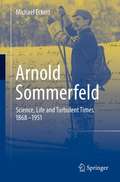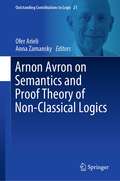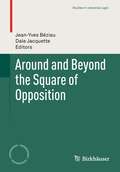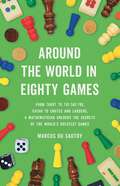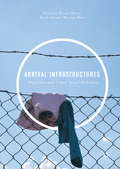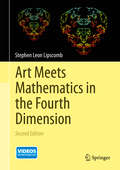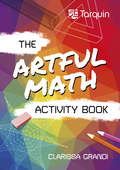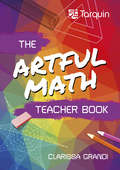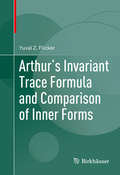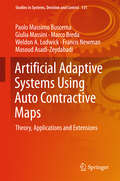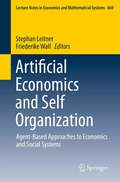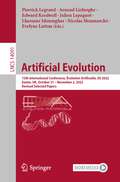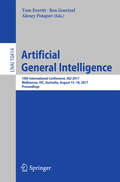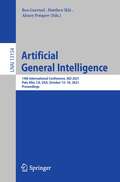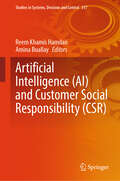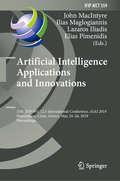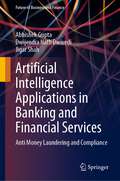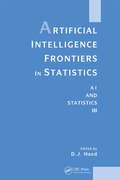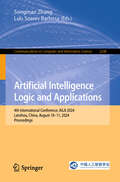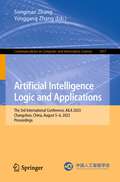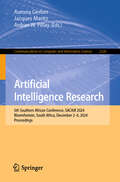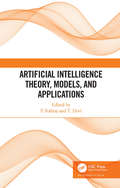- Table View
- List View
Armut im jungen Erwachsenenalter und der Wandel von Arbeitsmarkt, Wohlfahrtsstaat und Haushalten
by Sebastian LinkSebastian Link geht in diesem Buch der Frage nach, welche Auswirkungen mit dem Erwerbseinstiegsprozess verbundene Risiken (Arbeitslosigkeit, Niedriglohnbeschäftigung) und atypische Beschäftigungsverhältnisse auf die Armutsbetroffenheit junger Erwachsener in Deutschland haben. Mithilfe von Quer- und Längsschnittanalysen auf Basis des Sozio-Oekonomischen Panels zeigt er, dass nicht in erster Linie das gehäufte Auftreten von Erwerbsrisiken und atypischer Beschäftigung zu einem Armutsanstieg bei jungen Erwachsenen geführt hat, sondern die Verstärkung ihrer negativen finanziellen Folgen. Diese Verstärkung steht in einem Zusammenhang mit dem abnehmenden Schutz junger Erwachsener vor Armut durch Wohlfahrtsstaat und Haushalte.
Arnold Sommerfeld: Science, Life and Turbulent Times 1868-1951
by Michael EckertThe subject of the book is a biography of the theoretical physicist Arnold Sommerfeld (1868-1951). Although Sommerfeld is famous as a quantum theorist for the elaboration of the semi-classical atomic theory (Bohr-Sommerfeld model, Sommerfeld's fine-structure constant), his role in the history of modern physics is not confined to atoms and quanta. Sommerfeld left his mark in the history of mathematics, fluid mechanics, a number of physical subdisciplines and, in particular, as founder of a most productive "school" (Peter Debye, Wolfgang Pauli, Werner Heisenberg, Linus Pauling and Hans Bethe were his pupils, to name only the Nobel laureates among them). This biography is to a large extent based on primary source material (correspondence, diaries, unpublished manuscripts). It should be of particular interest to students who are keen to know more about the historical roots of modern science. Sommerfeld lived through turbulent times of German history (Wilhelmian Empire, Weimar Republic, Nazi period). His life, therefore, illustrates how science and scientists perform in changing social environments. From this perspective, the biography should also attract readers with a general interest in the history of science and technology.
Arnon Avron on Semantics and Proof Theory of Non-Classical Logics (Outstanding Contributions to Logic #21)
by Ofer Arieli Anna ZamanskyThis book is a collection of contributions honouring Arnon Avron’s seminal work on the semantics and proof theory of non-classical logics. It includes presentations of advanced work by some of the most esteemed scholars working on semantic and proof-theoretical aspects of computer science logic. Topics in this book include frameworks for paraconsistent reasoning, foundations of relevance logics, analysis and characterizations of modal logics and fuzzy logics, hypersequent calculi and their properties, non-deterministic semantics, algebraic structures for many-valued logics, and representations of the mechanization of mathematics.Avron’s foundational and pioneering contributions have been widely acknowledged and adopted by the scientific community. His research interests are very broad, spanning over proof theory, automated reasoning, non-classical logics, foundations of mathematics, and applications of logic in computer science and artificial intelligence. This is clearly reflected by the diversity of topics discussed in the chapters included in this book, all of which directly relate to Avron’s past and present works. This book is of interest to computer scientists and scholars of formal logic.
Around and Beyond the Square of Opposition (Studies in Universal Logic)
by Dale Jacquette Jean-Yves BéziauThe theory of oppositions based on Aristotelian foundations of logic has been pictured in a striking square diagram which can be understood and applied in many different ways having repercussions in various fields: epistemology, linguistics, mathematics, sociology, physics. The square can also be generalized in other two-dimensional or multi-dimensional objects extending in breadth and depth the original Aristotelian theory. The square of opposition from its origin in antiquity to the present day continues to exert a profound impact on the development of deductive logic. Since 10 years there is a new growing interest for the square due to recent discoveries and challenging interpretations. This book presents a collection of previously unpublished papers by high level specialists on the square from all over the world.
Around the World in Eighty Games: From Tarot to Tic-Tac-Toe, Catan to Chutes and Ladders, a Mathematician Unlocks the Secrets of the World's Greatest Games
by Marcus du SautoyA &“fun&” and &“unexpected&” (The Economist) global tour of the world&’s greatest games and the mathematics that underlies them Where should you move first in Connect 4? What is the best property in Monopoly? And how can pi help you win rock paper scissors? Spanning millennia, oceans and continents, countries and cultures, Around the World in Eighty Games gleefully explores how mathematics and games have always been deeply intertwined. Renowned mathematician Marcus du Sautoy investigates how games provided the first opportunities for deep mathematical insight into the world, how understanding math can help us play games better, and how both math and games are integral to human psychology and culture. For as long as there have been people, there have been games, and for nearly as long, we have been exploring and discovering mathematics. A grand adventure, Around the World in Eighty Games teaches us not just how games are won, but how they, and their math, shape who we are.
Arrival Infrastructures: Migration and Urban Social Mobilities
by Bruno Meeus Karel Arnaut Bas Van HeurThis volume introduces a strategic interdisciplinary research agenda on arrival infrastructures. Arrival infrastructures are those parts of the urban fabric within which newcomers become entangled on arrival, and where their future local or translocal social mobilities are produced as much as negotiated. Challenging the dominance of national normativities, temporalities, and geographies of “arrival,” the authors scrutinize the position and potential of cities as transnationally embedded places of arrival. Critically interrogating conceptions of migrant arrival as oriented towards settlement and integration, the volume directs attention to much more diverse migration trajectories that shape our cities today. Each chapter examines how migrants, street-level bureaucrats, local residents, and civil society actors build—with the resources they have at hand—the infrastructures that accommodate, channel, and govern arrival.
Art Meets Mathematics in the Fourth Dimension
by Stephen Leon LipscombTo see objects that live in the fourth dimension we humans would need to add a fourth dimension to our three-dimensional vision. An example of such an object that lives in the fourth dimension is a hyper-sphere or "3-sphere. " The quest to imagine the elusive 3-sphere has deep historical roots: medieval poet Dante Alighieri used a 3-sphere to convey his allegorical vision of the Christian afterlife in his Divine Comedy. In 1917, Albert Einstein visualized the universe as a 3-sphere, describing this imagery as "the place where the reader's imagination boggles. Nobody can imagine this thing. " Over time, however, understanding of the concept of a dimension evolved. By 2003, a researcher had successfully rendered into human vision the structure of a 4-web (think of an ever increasingly-dense spider's web). In this text, Stephen Lipscomb takes his innovative dimension theory research a step further, using the 4-web to reveal a new partial image of a 3-sphere. Illustrations support the reader's understanding of the mathematics behind this process. Lipscomb describes a computer program that can produce partial images of a 3-sphere and suggests methods of discerning other fourth-dimensional objects that may serve as the basis for future artwork.
Art and IR Theory: Visual Semiotic Games (Mathematics in Mind)
by Serdar Ş. GünerThis book examines the correspondence between international relations (IR) theories of structural realism and constructivism and paintings, notably the artwork of Mark Rothko and Jackson Pollock, in a game theory setting. This interdisciplinary approach, through the lens of game theory and semiotics, permits different, enriched interpretations of structural realism and constructivism. These theories constitute an axis of debate between social and systemic approaches to international politics, as well as an axis of differentiation between scientific realism and positivism as philosophies of science. As such, the interpretations explored in this book contribute to what we know about international relations, how semiotics intersect with strategic uncertainty, and explains these interactions in the proposed games model.The book’s use of game theory and semiotics generate ‘visual semiotic games’ (VSGs) that shed light on the debate axes through strategic uncertainty, interactions, and players’ interactive belief systems. VSGs will contribute to literature on experimental semiotics in the sense of players’ coordination behavior, beliefs, and artistic evaluations. The equilibria, interpreted through branches of philosophy of mind and theories of explanation, will reveal possibilities of agreement among players about which artwork representing the theory at hand is the best, opening innovative research perspectives for the discipline of IR theory.
Artful Math Activity Book
by Clarissa GrandiThe wonderful thing about mathematical art is that the most beautiful geometric patterns can be produced without needing to be able to draw, or be ‘good at art'. Mathematical art is accessible to learners of all ages: its algorithmic nature means that it simply requires the ability to follow instructions carefully and to use a pencil and ruler accurately. It is engaging, enriching, thoroughly enjoyable and is a great leveller in the classroom. Learners who may not normally shine in mathematics lessons will take your breath away with their creativity. Those who struggle with their mathematics will experience the joy of success through their mathematical art-making. The six Artful Maths activities in this book are hands-on tasks that will develop important skills such as hand-eye co-ordination, manual dexterity and design thinking, which is a valuable form of problem-solving. Decisions need to be made about placement, size and colour, all of which entail thinking about measurements, proportions and symmetry. They can be undertaken alone or witha teacher to draw out the mathematics underlying the patterns and to practice key content in the school curriculum. For ages 9 to 16+. Contents: Curves of Pursuit, Mazes and Labyrinths,Impossible Objects, Epicycloids,,Perfect Proportions, Parabolic Curves.
Artful Math Teacher Book
by Clarissa GrandiBook contains teacher notes, and access to downloadable templates and Powerpoint lesson plans. The wonderful thing about mathematical art is that the most beautiful geometric patterns can be produced without needing to be able to draw, or be ‘good at art'. Mathematical art is accessible to learners of all ages: its algorithmic nature means that it simply requires the ability to follow instructions carefully and to use a pencil and ruler accurately. It is engaging, enriching, thoroughly enjoyable and is a great leveller in the classroom. Learners who may not normally shine in mathematics lessons will take your breath away with their creativity. Those who struggle with their mathematics will experience the joy of success through their mathematical art-making. The six Artful Maths activities in this book are hands-on tasks that will develop important skills such as hand-eye co-ordination, manual dexterity and design thinking, which is a valuable form of problem-solving. Decisions need to be made about placement, size and colour, all of which entail thinking about measurements, proportions and symmetry. They can be undertaken alone or with a teacher to draw out the mathematics underlying the patterns and to practice key content in the school curriculum. For ages 9 to 16+. Contents: Curves of Pursuit, Mazes and Labyrinths, Impossible Objects, Epicycloids,,Perfect Proportions, Parabolic Curves.
Arthur's Invariant Trace Formula and Comparison of Inner Forms
by Yuval Z. FlickerThis monograph provides an accessible and comprehensive introduction to James Arthur's invariant trace formula, a crucial tool in the theory of automorphic representations. It synthesizes two decades of Arthur's research and writing into one volume, treating a highly detailed and often difficult subject in a clearer and more uniform manner without sacrificing any technical details. The book begins with a brief overview of Arthur's work and a proof of the correspondence between GL(n) and its inner forms in general. Subsequent chapters develop the invariant trace formula in a form fit for applications, starting with Arthur's proof of the basic, non-invariant trace formula, followed by a study of the non-invariance of the terms in the basic trace formula, and, finally, an in-depth look at the development of the invariant formula. The final chapter illustrates the use of the formula by comparing it for G' = GL(n) and its inner form G Arthur's Invariant Trace Formula and Comparison of Inner Forms will appeal to advanced graduate students, researchers, and others interested in automorphic forms and trace formulae. Additionally, it can be used as a supplemental text in graduate courses on representation theory.
Artificial Adaptive Systems Using Auto Contractive Maps: Theory, Applications And Extensions (Studies In Systems, Decision And Control #131)
by Paolo Massimo Buscema Weldon A. Lodwick Giulia Massini Marco Breda Francis Newman Masoud Asadi-ZeydabadiDescribes a newer approach to artificial adaptive systems, the auto contractive map.<P><P> This book offers an introduction to artificial adaptive systems and a general model of the relationships between the data and algorithms used to analyze them. It subsequently describes artificial neural networks as a subclass of artificial adaptive systems, and reports on the backpropagation algorithm, while also identifying an important connection between supervised and unsupervised artificial neural networks. <P> The book’s primary focus is on the auto contractive map, an unsupervised artificial neural network employing a fixed point method versus traditional energy minimization. This is a powerful tool for understanding, associating and transforming data, as demonstrated in the numerous examples presented here. A supervised version of the auto contracting map is also introduced as an outstanding method for recognizing digits and defects. In closing, the book walks the readers through the theory and examples of how the auto contracting map can be used in conjunction with another artificial neural network, the “spin-net,” as a dynamic form of auto-associative memory.
Artificial Economics and Self Organization: Agent-Based Approaches to Economics and Social Systems (Lecture Notes in Economics and Mathematical Systems #669)
by Stephan Leitner Friederike WallThis volume presents recent advances in the dynamic field of Artificial Economics and its various applications. Artificial Economics provides a structured approach to model and investigate economic and social systems. In particular, this approach is based on the use of agent-based simulations and further computational techniques. The main aim is to analyze the outcomes at the overall systems' level as results from the agents' behavior at the micro-level. These emergent characteristics of complex economic and social systems can neither be foreseen nor are they intended. The emergence rather makes these systems function. Artificial Economics especially facilitates the investigation of this emergent systems' behavior.
Artificial Evolution: 15th International Conference, Évolution Artificielle, EA 2022, Exeter, UK, October 31 – November 2, 2022, Revised Selected Papers (Lecture Notes in Computer Science #14091)
by Pierrick Legrand Nicolas Monmarché Evelyne Lutton Lhassane Idoumghar Julien Lepagnot Arnaud Liefooghe Edward KeedwellThis book constitutes the refereed post-conference proceedings of the 15th International Conference, Évolution Artificielle, EA 2022, held in Exeter, UK, during October 31–November 2, 2022.The 15 full papers were carefully reviewed and selected from 18 submissions. The papers cover a wide range of topics in the field of artificial evolution, including, but not limited to: evolutionary computation, evolutionary optimization, coevolution, artificial life, population dynamics, theory, algorithmic and modeling, implementations.
Artificial General Intelligence: 10th International Conference, AGI 2017, Melbourne, VIC, Australia, August 15-18, 2017, Proceedings (Lecture Notes in Computer Science #10414)
by Tom Everitt, Ben Goertzel and Alexey PotapovThis book constitutes the proceedings of the 10th International Conference on Artificial General Intelligence, AGI 2017, held in Melbourne, VIC, Australia, in August 2017. The 24 regular papers presented in this book together with 1 short paper were carefully reviewed and selected from 35 submissions. They cover topics such as architectures; mathematical foundations; algorithms; safety; understanding; human cognition; and philosophy.
Artificial General Intelligence: 14th International Conference, AGI 2021, Palo Alto, CA, USA, October 15–18, 2021, Proceedings (Lecture Notes in Computer Science #13154)
by Ben Goertzel Alexey Potapov Matthew IkléThis book constitutes the refereed proceedings of the 14th International Conference on Artificial General Intelligence, AGI 2021, held as a hybrid event in San Francisco, CA, USA, in October 2021.The 36 full papers presented in this book were carefully reviewed and selected from 50 submissions. The papers cover topics from foundations of AGI, to AGI approaches and AGI ethics, to the roles of systems biology, goal generation, and learning systems, and so much more.
Artificial Intelligence (Studies in Systems, Decision and Control #517)
by Reem Khamis Hamdan Amina BuallayThe impact of artificial intelligence (AI) on business and society has been significant, with the incorporation of AI technologies such as robots, facial recognition, algorithms, and natural language processing into business leading to both corporate benefits and potential challenges for stakeholders. The question of how to engage in responsible business practices in the era of AI is an important one, and there is a need for more research on the relationship between AI and corporate social responsibility (CSR). As AI becomes more prevalent, there is a growing focus on the ethical implications of AI and the potential for AI to perpetuate biases or to displace human workers. CSR initiatives can include considerations of ethical AI in the development and use of AI systems. AI has the potential to solve many global challenges and improve people's lives, but it can also have negative consequences if not developed and used responsibly. CSR initiatives can focus on the social impact of AI,including efforts to ensure that the benefits of AI are distributed fairly and that AI is used for the common good. CSR initiatives often involve engaging with stakeholders, including employees, customers, and communities, to understand their needs and concerns and to ensure that their interests are taken into account. This can include engaging with stakeholders about the use of AI in the organization and its potential impactsThe adoption of AI in business is changing many aspects of doing business in a socially responsible manner, and there is a need to examine the potential unethical behaviors and novel ways of engaging in CSR that may arise. This book aims to focus on AI and CSR, and to advance our understanding of the role of AI in organizations and the literature on CSR by assembling high-quality papers with a strong connection between theory and practice.
Artificial Intelligence Applications and Innovations: 15th IFIP WG 12.5 International Conference, AIAI 2019, Hersonissos, Crete, Greece, May 24–26, 2019, Proceedings (IFIP Advances in Information and Communication Technology #559)
by Elias Pimenidis Lazaros Iliadis Ilias Maglogiannis John MacIntyreThis book constitutes the refereed proceedings of the 15th IFIP WG 12.5 International Conference on Artificial Intelligence Applications and Innovations, AIAI 2019, held in Hersonissos, Crete, Greece, in May 2019.The 49 full papers and 6 short papers presented were carefully reviewed and selected from 101 submissions. They cover a broad range of topics such as deep learning ANN; genetic algorithms - optimization; constraints modeling; ANN training algorithms; social media intelligent modeling; text mining/machine translation; fuzzy modeling; biomedical and bioinformatics algorithms and systems; feature selection; emotion recognition; hybrid Intelligent models; classification - pattern recognition; intelligent security modeling; complex stochastic games; unsupervised machine learning; ANN in industry; intelligent clustering; convolutional and recurrent ANN; recommender systems; intelligent telecommunications modeling; and intelligent hybrid systems using Internet of Things. The papers are organized in the following topical sections:AI anomaly detection - active learning; autonomous vehicles - aerial vehicles; biomedical AI; classification - clustering; constraint programming - brain inspired modeling; deep learning - convolutional ANN; fuzzy modeling; learning automata - logic based reasoning; machine learning - natural language; multi agent - IoT; nature inspired flight and robot; control - machine vision; and recommendation systems.
Artificial Intelligence Applications in Banking and Financial Services: Anti Money Laundering and Compliance (Future of Business and Finance)
by Abhishek Gupta Dwijendra Nath Dwivedi Jigar ShahThis book discusses all aspects of money laundering, starting from traditional approach to financial crimes to artificial intelligence-enabled solutions. It also discusses the regulators approach to curb financial crimes and how syndication among financial institutions can create a robust ecosystem for monitoring and managing financial crimes. It opens with an introduction to financial crimes for a financial institution, the context of financial crimes, and its various participants. Various types of money laundering, terrorist financing, and dealing with watch list entities are also part of the discussion. Through its twelve chapters, the book provides an overview of ways in which financial institutions deal with financial crimes; various IT solutions for monitoring and managing financial crimes; data organization and governance in the financial crimes context; machine learning and artificial intelligence (AI) in financial crimes; customer-level transaction monitoring system; machine learning-driven alert optimization; AML investigation; bias and ethical pitfalls in machine learning; and enterprise-level AI-driven Financial Crime Investigation (FCI) unit. There is also an Appendix which contains a detailed review of various data sciences approaches that are popular among practitioners.The book discusses each topic through real-life experiences. It also leverages the experience of Chief Compliance Officers of some large organizations to showcase real challenges that heads of large organizations face while dealing with this sensitive topic. It thus delivers a hands-on guide for setting up, managing, and transforming into a best-in-class financial crimes management unit. It is thus an invaluable resource for researchers, students, corporates, and industry watchers alike.
Artificial Intelligence Frontiers in Statistics: Al and Statistics III
by David J. HandThis book presents a summary of recent work on the interface between artificial intelligence and statistics. It does this through a series of papers by different authors working in different areas of this interface. These papers are a selected and referenced subset of papers presented at the 3rd Interntional Workshop on Artificial Intelligence and Statistics, Florida, January 1991.
Artificial Intelligence Logic and Applications: 4th International Conference, AILA 2024, Lanzhou, China, August 10–11, 2024, Proceedings (Communications in Computer and Information Science #2248)
by Songmao Zhang Luis Soares BarbosaThis book constitutes the proceedings of the 4th International Conference on Artificial Intelligence Logic and Applications, AILA 2024, held in Lanzhou, China, during August 10–11, 2024. The 16 full papers and the 11 short papers included in this volume were carefully reviewed and selected from 45 submissions. The papers cover the following topics: AI logic foundation; AI logic reasoning; AI logic applications.
Artificial Intelligence Logic and Applications: The 2nd International Conference, AILA 2022, Shanghai, China, August 26–28, 2022, Proceedings (Communications in Computer and Information Science #1657)
by Songmao Zhang Yixiang ChenThis book constitutes refereed proceedings of the 2nd International Conference on Artificial Intelligence Logic and Applications 2022 held in Shanghai, China from August 26–28, 2022.The 20 full papers presented in this volume were carefully reviewed and selected from a total of 27 submissions. The papers in the volume are organised according to the following topical headings: program logic; fuzzy logic; applications; author index.
Artificial Intelligence Logic and Applications: The 3rd International Conference, AILA 2023, Changchun, China, August 5–6, 2023, Proceedings (Communications in Computer and Information Science #1917)
by Songmao Zhang Yonggang ZhangThis book constitutes the proceedings of the Third International Conference, AILA 2023, held in Changchun, China, during August 5–6, 2023. The 26 full papers and the 10 short papers included in this volume were carefully reviewed and selected from 56 submissions. This volume aims to provide novel ideas, original research achievements, and practical experiences in a broad range of artificial intelligence logic and applications.
Artificial Intelligence Research: 5th Southern African Conference, SACAIR 2024, Bloemfontein, South Africa, December 2–6, 2024, Proceedings (Communications in Computer and Information Science #2326)
by Aurona Gerber Jacques Maritz Anban W. PillayThis book constitutes the refereed proceedings of the 5th Southern African Conference on Artificial Intelligence Research, SACAIR 2024, held in Bloemfontein, South Africa, during December 2–6, 2024. The 29 full papers presented in these proceedings were carefully reviewed and selected from 101 submissions. The papers are organized in the following topical sections: algorithmic and Data Driven AI; socio-technical and human-centred AI (Information Systems); responsible and Ethical AI (Philosophy, Law and Humanities); symbolic AI and Knowledge Representation and Reasoning.
Artificial Intelligence Theory, Models, and Applications
by P. KalirajThis book examines the fundamentals and technologies of Artificial Intelligence (AI) and describes their tools, challenges, and issues. It also explains relevant theory as well as industrial applications in various domains, such as healthcare, economics, education, product development, agriculture, human resource management, environmental management, and marketing. The book is a boon to students, software developers, teachers, members of boards of studies, and researchers who need a reference resource on artificial intelligence and its applications and is primarily intended for use in courses offered by higher education institutions that strive to equip their graduates with Industry 4.0 skills. FEATURES: Gender disparity in the enterprises involved in the development of AI-based software development as well as solutions to eradicate such gender bias in the AI world A general framework for AI in environmental management, smart farming, e-waste management, and smart energy optimization The potential and application of AI in medical imaging as well as the challenges of AI in precision medicine AI’s role in the diagnosis of various diseases, such as cancer and diabetes The role of machine learning models in product development and statistically monitoring product quality Machine learning to make robust and effective economic policy decisions Machine learning and data mining approaches to provide better video indexing mechanisms resulting in better searchable results ABOUT THE EDITORS: Prof. Dr. P. Kaliraj is Vice Chancellor at Bharathiar University, Coimbatore, India. Prof. Dr. T. Devi is Professor and Head of the Department of Computer Applications, Bharathiar University, Coimbatore, India.

